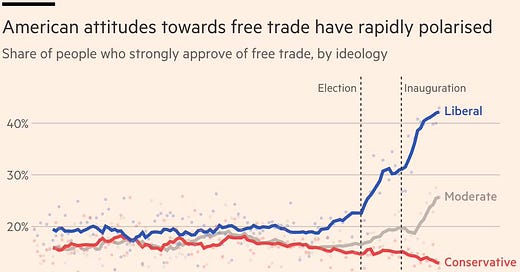From Protest to Parrot: How the Left Learned to Love Free Trade
The American Left Once Fought Globalism. Now They’re Its Biggest Fans.
Once, the American left marched in the streets against NAFTA and the WTO. Their signs warned of lost jobs, shuttered factories, and the rule of corporate capital. Labor unions punished Democrats who voted for free trade deals. Environmentalists, socialists, and blue-collar workers joined arms in defiant opposition to globalization’s wrecking ball. That was then.
Now, take a look at the latest numbers.
Since Donald Trump won back the White House in 2024, liberal support for free trade has surged. According to data from the Polarization Research Lab, the share of liberals who “strongly approve” of free trade has more than doubled since the election. Conservatives, meanwhile, have held steady or declined.
This isn’t a shift born of conviction. It’s pure, uncut reaction.
The same progressives who once condemned free trade as a capitalist Trojan horse now embrace it—because Trump doesn’t. The same labor-linked Democrats who were once rewarded by donors for opposing trade liberalization (Osgood, 2022) now cheer what they once feared. This is not a new policy position. It’s negative partisanship dressed up as economic principle.
What happened to the Democratic Party of Dick Gephardt and Bernie Sanders—the party that stood with the working man against multinational conglomerates?
The evidence of historic resistance runs deep. Jansa and Hoyman (2018) found that private-sector unions—those actually vulnerable to foreign competition—cut funding by 6% when Democrats backed free trade bills. Arditi (2019) documented how left-aligned activists built coalitions across ideological lines to protest the WTO and NAFTA, defending local autonomy and worker dignity. Even in the UK, as Jeremy Tranmer (2020) shows, the Labour Party spent decades battling European integration out of fear that Brussels would trample national labor protections.
So why the reversal?
Because the opposition isn’t to trade—it’s to Trump. And in today’s America, if Trump’s for it, the left must be against it... until they’re not.
This is not how a serious country governs. Trade policy should be based on national interest, not tribal reflexes. It should prioritize the American worker, the American factory, and the American town—the very things the Left once claimed to defend, until it became more convenient to play ideological ping-pong.
The left has abandoned its old gospel. And what fills the vacuum is not principle, but partisanship. The new progressive trade position is simple: if Trump imposes tariffs, free trade must be good. If Trump says “America First,” then “World First” becomes the slogan by default.
They used to chant “The world is not for sale.”
Now, they cheer when it is—so long as it’s not Trump at the register.
Sources:
Osgood, Iain (2022). Representation and Reward: The Left-Wing Anti-Globalization Alliance.
Jansa, Joshua M. & Hoyman, Michele (2018). Do Unions Punish Democrats? Free-Trade Votes and Labor PAC Contributions.
Waal, Jeroen van der & Koster, Willem de (2018). Populism and Support for Protectionism.
Arditi, David (2019). The Contradictions of Opposition to Free Trade.
Tranmer, Jeremy (2020). Nationalism, Internationalism, and Anti-Capitalism: Left-Wing Opposition to the EU.
Polarization Research Lab (2025). America’s Political Pulse: Free Trade Attitudes by Ideology.




